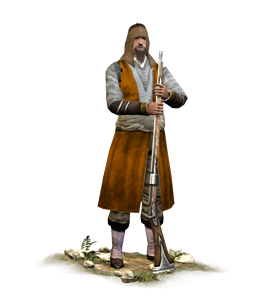Bargir Infantry (ETW unit)
| Bargir Infantry | |
|---|---|

| |
| Category: | Infantry |
| Class: | Line Infantry |
| Men: | 40 / 80 / 120 / 160 |
| Range: | 70 |
| Accuracy: | 40 |
| Reloading skill: | 25 |
| Ammunition: | 15 |
| Melee attack: | 6 |
| Charge bonus: | 9 |
| Defence: | 15 |
| Morale: | 7 |
| Turns to train: | 1 |
| Recruitment cost: | 1050 |
| Upkeep cost: | 260 |
| Requires | |
| Building (minimum level) | |
| Barracks | |
| Military Governor's Barracks | |
Heavily influenced by European military thinking, Bargirs are a match to most line infantry regiments.
With their equipment paid for by the state and their organisation based on tried and tested European principles, Bargir infantry are more reliable than most Indian foot soldiers. Armed with good muskets and often trained or led by mercenary European officers, Bargirs provide their general with a range of tactical options on the battlefield.
Traditionally, armies on the Indian subcontinent were geared toward mounted troops who enjoyed a high status compared to infantry. Footsoldiers, mainly drawn from the lowest echelons of society, were typically a disorganised rabble, useful to a commander only because they added numbers to an army. They were expendable, poorly-equipped and easily-dismayed in battle, often making them a liability rather than an asset.
The social mobility which characterised Maratha society allowed a more modern view of the role of infantry to come to prevalence. Through observation of European methods, the equipment and training of Maratha infantry began to improve, allowing the successful use of advanced manoeuvres and firing drills.
Abilities
- Can guard
- Can hide in woodland
- Grappling hooks
- Resistant to heat fatigue
- Resistant to morale shocks
Technological abilities
Available for:
| |
| |

